压力变送器水和水蒸气的动力粘度表
水和水蒸气(热力、粘性、传热)计算表(部分)
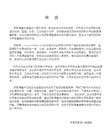
1.计算表输入参数为温度T和压力P,所有输入和输出都用SI单位制
2.计算表所有公式来自于IAPWS并使用IAPWS提供的数据验证过,具体如下:
a) 吉布斯/亥姆霍兹自由能g/f,内能u,熵s,焓h,比热容Cp、Cv,声速w的公式来自于IAPWS-R7(IF97)
b) 比体积v在区域1和2的公式来自于IAPWS-IF97,区域3的公式来自于IAPWS-SR5
c) 粘性系数mu的公式来自于IAPWS-R12
d) 传热系数lambda的公式来自于IAPWS-R15(包含部分推导换算)
3.计算表适用范围如下:
a) 温度273.15-1073.15K,压力0-100MPa
(超出此范围不会自动显示无效)
b) 目前只包含IF97区域1、2以及区域3的部分子域(a-f和t,其他区域将显示不适用invalid)
(目前例外区域为在630-680K,19-25MPa范围内的部分区域)
4.计算表只使用excel自带的函数,不使用宏。
动力粘度单位换算表
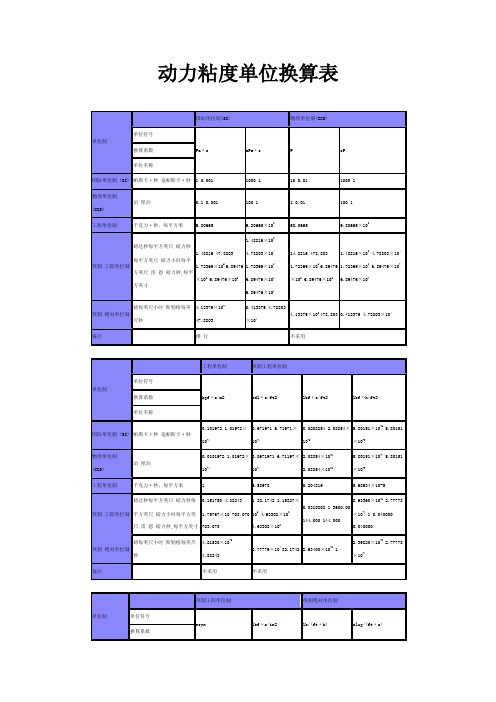
动力粘度单位换算表流体在流动时,相邻流体层间存在着相对运动,则该两流体层间会产生摩擦阻力,称为粘滞力。
粘度是用来衡量粘滞力大小的一个物性数据。
其大小由物质种类、温度、浓度等因素决定。
粘度一般是动力粘度的简称,其单位是帕·秒(Pa·s)或毫帕·秒(mPa·s)。
粘度分为动力粘度、运动粘度、相对粘度,三者有区别,不能混淆。
粘度还可用涂—4或涂—1杯测定,其单位为秒(s)。
(动力)粘度符号是μ,单位是帕斯卡秒(Pa·s)由下式定义:L=μ·μ0/hμ0——平板在其自身的平面内作平行于某一固定平壁运动时的速度h——平板至固定平壁的距离。
但此距离应足够小,使平板与固定平壁间的流体的流动是层流L——平板运动过程中作用在平板单位面积上的流体摩擦力运动粘度符号是v,运动粘度是在工程计算中,物质的动力粘度与其密度之比,其单位为:(m2/s)。
单位是二次方米每秒(m2/s)v=μ/p粘度有动力粘度,其单位:帕斯卡秒(Pa·s);在石油工业中还使用"恩氏粘度",它不是上面介绍的粘度概念。
而是流体在恩格拉粘度计中直接测定的读数。
-------------------粘度的度量方法分为绝对粘度和相对粘度两大类。
绝对粘度分为动力粘度和运动粘度两种;相对粘度有恩氏粘度、赛氏粘度和雷氏粘度等几种表示方法。
1、动力粘度η在流体中取两面积各为1m2,相距1m,相对移动速度为1m/s时所产生的阻力称为动力粘度。
单位Pa.s(帕.秒)。
过去使用的动力粘度单位为泊或厘泊,泊(Poise)或厘泊为非法定计量单位。
1Pa.s=1N.s/m2=10P泊=10的3次方cp=1KcpsASTM D445标准中规定用运动粘度来计算动力粘度,即η=ρ.υ式中η-动力粘度,Pa.s期目标制ρ-密度,kg/m3 υ-运动粘度,m2/s我国国家标准GB/T506-82为润滑油低温动力粘度测定法。
水蒸气参数表

水与水蒸气1kg水从常温转化为100℃水蒸气需消耗多少度电?水从液态转换为蒸汽,需要的热量为两部分:设常温温度为20℃,压强为一个大气压强,已知水的沸点是100℃,水的相对分子质量为18g/mol,水的比热是4.2kj/(kg·℃),气化热是40.8kj/mol。
则:1. 从20℃水变成100度水所需能量=1×(100-20)×4.2=336千焦;2. 从100℃水变成100℃水蒸气液体分子要克服分子势能做功,所需能量=40.8×(1000/18)=2266.7千焦。
合计所需总能量=336+2266.7=2602.7千焦。
1度=1000瓦时=3600千焦,2602.7千焦/3600千焦=0.723(度),即:将1公斤20度的水转化为100度水蒸气需消耗0.723度电。
温度(℃)压强(kgf/cm2)重度(kg/cm3)热焓(kJ/kg)汽化潜热(kJ/kg)定压热容(kJ/kg·K)导热系数λ(W/m·K)导温系数α×103(m2/h)粘度μ×106(kg·s/m2)运动粘度ν×106(m2/s)Pr100 1.03 0.598 2670 2250 2.135 2.4 66.9 1.22 20.02 1.08 120 2.02 1.121 2720 2195 2.203 2.6 37.8 1.31 11.46 1.09 140 3.69 1.966 2730 2140 2.312 2.8 22.07 1.38 6.89 1.12 160 6.30 3.258 2755 2078 2.478 3.0 13.40 1.46 4.39 1.18 180 10.23 5.157 **** **** 2.705 3.3 8.42 1.54 2.93 1.25 200 15.86 7.862 2790 1935 3.020 3.6 5.37 1.63 2.03 1.36 220 23.66 11.62 2792 1854 3.400 3.9 3.54 1.72 1.45 1.47 240 34.14 16.76 2794 1768 3.880 4.3 2.37 1.81 1.06 1.61 260 47.87 23.72 2791 1660 4.470 4.8 1.63 1.92 0.794 1.75 280 65.46 33.19 2772 1543 5.240 5.5 1.14 2.03 0.600 1.90 300 87.61 46.21 2750 1405 6.280 6.3 0.778 2.15 0.461 2.13 320 115.12 64.72 2700 1238 8.22 7.5 0.509 2.33 0.353 2.50 340 148.96 92.76 2620 1025 12.73 9.3 0.292 2.57 0.272 3.35 360 190.42 144.0 2480 721 23.1 12.8 0.139 2.97 0.202 5.23370 214.68 203.0 2322 440 56.6 17.1 0.054 3.44 0.166 11.10温度(℃)压强(kgf/cm2)热焓(kJ/kg)折标系数(kgce/kg)100 1.03 2670 0.09110 120 2.02 2720 0.09281 140 3.69 2730 0.09315 160 6.30 2755 0.09400 180 10.23 2774 0.09465 200 15.86 2790 0.09520 220 23.66 2792 0.09527 240 34.14 2794 0.09533 260 47.87 2791 0.09523 280 65.46 2772 0.09458 300 87.61 2750 0.09383 320 115.12 2700 0.09213 340 148.96 2620 0.08940 360 190.42 2480 0.08462 370 214.68 2322 0.07923。
常见介质粘度表
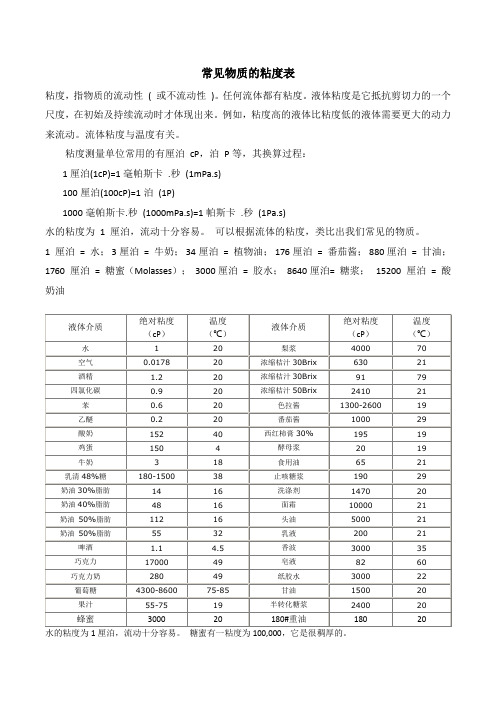
常见物质的粘度表
粘度,指物质的流动性( 或不流动性)。
任何流体都有粘度。
液体粘度是它抵抗剪切力的一个尺度,在初始及持续流动时才体现出来。
例如,粘度高的液体比粘度低的液体需要更大的动力来流动。
流体粘度与温度有关。
粘度测量单位常用的有厘泊cP,泊P等,其换算过程:
1厘泊(1cP)=1毫帕斯卡.秒(1mPa.s)
100厘泊(100cP)=1泊(1P)
1000毫帕斯卡.秒(1000mPa.s)=1帕斯卡.秒(1Pa.s)
水的粘度为 1 厘泊,流动十分容易。
可以根据流体的粘度,类比出我们常见的物质。
1 厘泊= 水; 3厘泊= 牛奶; 34厘泊= 植物油; 176厘泊= 番茄酱; 880厘泊= 甘油;1760 厘泊= 糖蜜(Molasses); 3000厘泊= 胶水; 8640厘泊= 糖浆; 15200 厘泊= 酸奶油
水的粘度为1厘泊,流动十分容易。
糖蜜有一粘度为100,000,它是很稠厚的。
1厘泊=水;10,000厘泊=Honeyo;500厘泊=植物油;100,000厘泊=Molasseso;2,500厘泊=马达油
(1)铁矿
边界品位:TFe≥20%,
工业品位:TFe≥25%,
矿体最低可采厚度:2m
夹石剔除厚度:2m
(2)铅锌矿
氧化矿:铅边界品位(%):≥0.7;最低工业品位(%):≥1.5;锌边界品位(%):≥1.5;最低工业品位(%):≥3;
硫化矿:铅边界品位(%):≥0.5;最低工业品位(%):≥1;锌边界品位(%):≥0.5;最低工业品位(%):≥1;
最低可采厚度(m):1;
夹石剔除厚度(m):2;。
动力黏度换算表
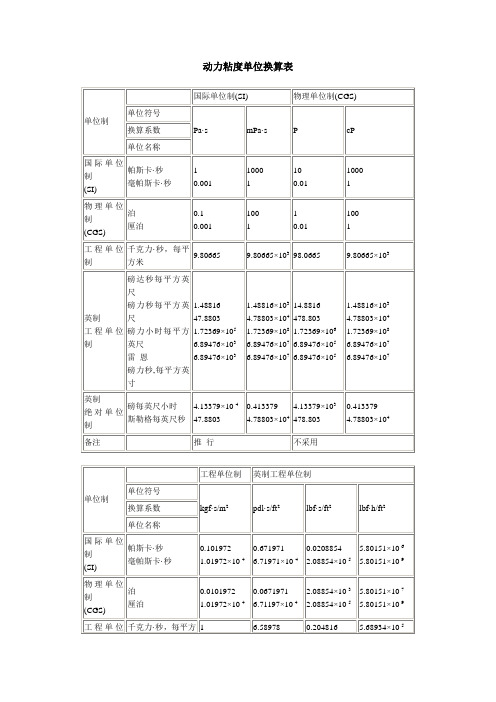
98.0665
9.80665×103
英制
工程单位制
磅达秒每平方英尺
磅力秒每平方英尺
磅力小时每平方英尺
雷恩
磅力秒,每平方英寸
1.48816
47.8803
1.72369×105
6.89476×103
6.89476×103
1.48816×103
4.78803×104
1.72369×108
0.101972
1.01972×10-4
0.671971
6.71971×10-4
0.0208854
2.08854×10-5
5.80151×10-6
5.80151×10-9
物理单位制
(CGS)
泊
厘泊
0.0101972
1.01972×10-4
0.0671971
6.71197×10-4
2.08854×10-3
703.070
1
32.1742
1.15827×105
4.63308×103
4.63308×103
0.0310808
1
3600.00
144.000
144.000
8.63360×10-6
2.77778×10-4
1
0.040000
0.040000
英制
绝对单位制
磅每英尺小时
斯勒格每英尺秒
4.21530×10-5
6.94445×10-3
6.00000×10-8
6.94445×10-4
1
1.1582×106
8.63400×106
1
备注
不采用
不采用
饱和水蒸气分压力和水气化潜热工具表
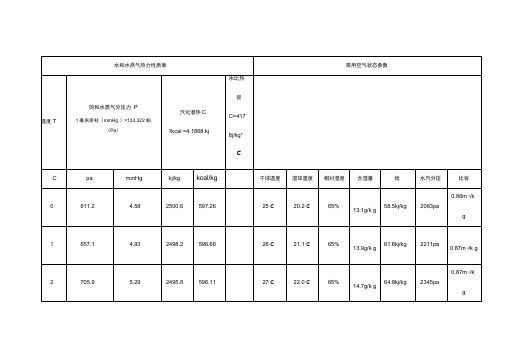
空调铜管规格尺寸
一匹的冷媒管是6.35-9.52、
一匹半的是6.35-12.7、
两匹的是9.52-12.7、/6.35-12.7
大于两匹的是9.52/12.7-15.88 、
五匹是9.52/12.7-19.05
分转换:
英制单位与国际单位转换
1英寸=25.4毫米=8分
所以1分=8/25.4=3.175 毫米
空调铜管理论重量
不同管径的铜管其长度与重量之间的关系如果要精确计算公式:
(D1 D2)* n*d*L* p*M/2 ,
其中:D1 —铜管外径,D2 —铜管内径,d —铜管壁厚,L —铜管长度,p—铜管密度,M —铜管单价,元/KG(Ton); 按以上公式计算很麻烦,而且工程报价不需要这么精确,一般报价都留有裕度。
不同管径铜管的长度与重量之间的大致关系即经验数据列表如下,其中以1米长为单位:
目前国内的内螺纹管管径主要有:C 12.7mm、C 9.52mm、C 9mm、C 7mm、C 6.35mm、C 5mm 等几种规格,其中C 9.52mm、C 7mm 应用最为普遍;。
水的粘度计算表

水的黏度表(0~40℃)水的物理性质F3Viscosity decreases with pressure(at temperatures below 33°C)Viscous flow occurs by molecules moving through the voids that exist between them. As the pressure increases, the volume decreases and the volume of these voids reduces, so normally increasing pressure increases the viscosity.Water's pressure-viscosity behavior [534] can be explained by the increased pressure (up to about 150 MPa) causing deformation, so reducing the strength of the hydrogen-bonded network, which is also partially responsible for the viscosity. This reduction in cohesivity more than compensates for the reduced void volume. It is thus a direct consequence of the balance between hydrogen bonding effects and the van der Waals dispersion forces [558] in water; hydrogen bonding prevailing at lower temperatures and pressures. At higher pressures (and densities), the balance between hydrogen bonding effects and the van der Waals dispersion forces is tipped in favor of the dispersion forces and the remaining hydrogen bonds are stronger due to the closer proximity of the contributing oxygen atoms [655]. Viscosity, then, increases with pressure. The dashed line (opposite) indicates the viscosity minima.The variation of viscosity with pressure and temperature has been used as evidence that the viscosity is determined more by the extent of hydrogen bonding rather than hydrogen bonding strength.Self-diffusion is also affected by pressure where (at low temperatures) both the translational and rotational motion of water anomalously increase as the pressure increases.Welcome To Download !!!欢迎您的下载,资料仅供参考!。
水的粘度计算表

水的黏度表(0~40℃)水的物理性质F3??? Viscosity decreases with pressure(at temperatures below 33°C)Viscous flow occurs by molecules moving through the voids that exist between them. As the pressure increases, the volume decreases and the volume of these voids reduces, so normally increasing pressure increases the viscosity.Water's pressure-viscosity behavior [534] can be explained by the increased pressure (up to about 150 MPa) causing deformation, so reducing the strength of the hydrogen-bonded network, which is also partially responsible for the viscosity. This reduction in cohesivity more than compensates for the reduced void volume. It is thus a direct consequence of the balance between hydrogen bonding effects and the van der Waals dispersion forces [558] in water; hydrogen bonding prevailing at lower temperatures and pressures. At higher pressures (and densities), the balance between hydrogen bonding effects and the van der Waals dispersion forces is tipped in favor of the dispersion forces and the remaining hydrogen bonds are stronger due to the closer proximity of the contributing oxygen atoms [655]. Viscosity, then, increases with pressure. The dashed line (opposite) indicates the viscosity minima.The variation of viscosity with pressure and temperature has been used as evidence that the viscosity is determined more by the extent of hydrogen bonding rather than hydrogen bonding strength.Self-diffusion is also affected by pressure where (at low temperatures) both the translational and rotational motion of water anomalously increase as the pressure increases.。
常见介质粘度表

常见物质的粘度表
粘度,指物质的流动性( 或不流动性).任何流体都有粘度.液体粘度是它抵抗剪切力的一个尺度,在初始及持续流动时才体现出来.例如,粘度高的液体比粘度低的液体需要更大的动力来流动。
流体粘度与温度有关.
粘度测量单位常用的有厘泊cP,泊P等,其换算过程:
1厘泊(1cP)=1毫帕斯卡.秒(1mPa。
s)
100厘泊(100cP)=1泊(1P)
1000毫帕斯卡.秒(1000mPa。
s)=1帕斯卡.秒(1Pa。
s)
水的粘度为 1 厘泊,流动十分容易。
可以根据流体的粘度,类比出我们常见的物质。
1 厘泊= 水; 3厘泊= 牛奶; 34厘泊= 植物油; 176厘泊= 番茄酱; 880厘泊= 甘油;1760 厘泊= 糖蜜(Molasses); 3000厘泊= 胶水; 8640厘泊= 糖浆; 15200 厘泊= 酸奶油
水的粘度为1厘泊,流动十分容易。
糖蜜有一粘度为100,000,它是很稠厚的。
1厘泊=水;10,000厘泊=Honeyo;500厘泊=植物油;100,000厘泊=Molasseso; 2,500厘泊=马达油。
水的粘度计算表

水的黏度表(0~40℃)水的物理性质F3??? Viscosity decreases with pressure(at temperatures below 33°C)Viscous flow occurs by molecules moving through the voids that exist between them. As the pressure increases, the volume decreases and the volume of these voids reduces, so normally increasing pressure increases the viscosity.Water's pressure-viscosity behavior [534] can be explained by the increased pressure (up to about 150 MPa) causing deformation, so reducing the strength of the hydrogen-bonded network, which is also partially responsible for the viscosity. This reduction in cohesivity more than compensates for the reduced void volume. It is thus a direct consequence of the balance between hydrogen bonding effects and the van der Waals dispersion forces [558] in water; hydrogen bonding prevailing at lower temperatures and pressures. At higher pressures (and densities), the balance between hydrogen bonding effects and the van der Waals dispersion forces is tipped in favor of the dispersion forces and the remaining hydrogen bonds are stronger due to the closer proximity of the contributing oxygen atoms [655]. Viscosity, then, increases with pressure. The dashed line (opposite) indicates the viscosity minima.The variation of viscosity with pressure and temperature has been used as evidence that the viscosity is determined more by the extent of hydrogen bonding rather than hydrogen bonding strength.Self-diffusion is also affected by pressure where (at low temperatures) both the translational and rotational motion of water anomalously increase as the pressure increases.。
压力单位和粘度单位换算表

力单位换算表牛顿(N)千克力(Kgf)克力(gf)达因(dyn)磅力(lbf)磅达(pdl)1 0.102 1.02x1021050.2248 7.2339.80665 1 1039.80665x105 2.2046 70.9310-5 1.02x10-5 1.02x10-3 1 2.248x10-67.233x10-5 4.448 0.4536 4.536x102 4.448x105 1 32.1740.1383 1.41x10-2 1.41x10-5 1.383x104 3.108x10-2 1压力单位换算表标准大气压巴千克力/厘米2工程大气压磅力/英寸2托(毫米汞柱)毫米水柱帕atm bar Kgf/cm2at Psi(lbf/in2) Torr(mmHg)mmH2O Pa(N/m2)1atm 1 1.01325 1.033 / 14.7 760 10332 101325 1bar 0.9869 1 1.01972 1.01792 14.504 750.062 10197.2 100000 1kgf/cm20.9678 0.98067 1 1 14.22 735.6 10000 980671at 0.9678 0.98067 1 1 14.22 735.6 10000 98067 1psi 0.06805 0.06895 0.07031 0.07031 151.7149 703.07 6894.76 1Torr 0.00132 0.00133 0.00136 0.00136 0.01934 113.6 133.3 1mmH2O 0.00009680.000098 0.0001 0.0001 0.00142 0.07356 19.8067 1pa 0.00001 0.00001 0.00001 0.00001 0.00014 0.0075 0.10197 11MPa(N/mm2)=103KPa=104hPa=106Pa(N/m2)1bar=103mbar0.1MPa=1atm=1bar=1Kgf/cm2=76cm Hg=10m H2O粘度的表示方法及换算表示方法说明动力粘度η在流体中取两面积各为1cm2,相距1cm的两个油层,当其中一个油层以1cm/s的速度作相对运动时所产生的阻力称为动力粘度,动力粘度的法定计量单位为Pa·s1Pa·s (N·s/m2)=10 P(泊)=103 cP(厘泊)动力粘度用旋转粘度计或落球式粘度计测定公斤力·秒/米2(kgf· s/m2)帕斯卡·秒(Pa·s)达因·秒/厘米2(泊)(P)公斤力·时/米 2(kgf·h/m2)牛顿·时/米2(N·h/m2)磅力·秒/英尺2(lbf·s/ft2)磅力·秒/英寸2(lbf·s/in2)1 9.81 98.1 278x10-6 2.73x10-30.205 1.42x10-3运动粘度V=η/ρ流体的动力粘度η与同温度下该流体的密度ρ的比值称为运动粘度,运动粘度的单位是m2/s,常用的单位是mm2/s(10-6m2/s)1m2/s = 104S t(斯)= 106c S t(厘斯)根据ISO国际标准,基本上以40°c和100°c运动粘度划分油品的粘度牌号,同时也以这两个温度的运动粘度来计算粘度值米2/秒(m2/s)厘米2/秒(斯)(cm2/s)毫米2/秒(厘斯)(mm2/s)米2/时(m2/h)码2/秒(yd2/s)英尺2/秒(ft2/s)英尺2/时(ft2/h)1 1041063600 1.196 10.76 38.75x103恩氏粘度°EV = 7.31°E - 6.31/°E。
动力黏度单位换算表
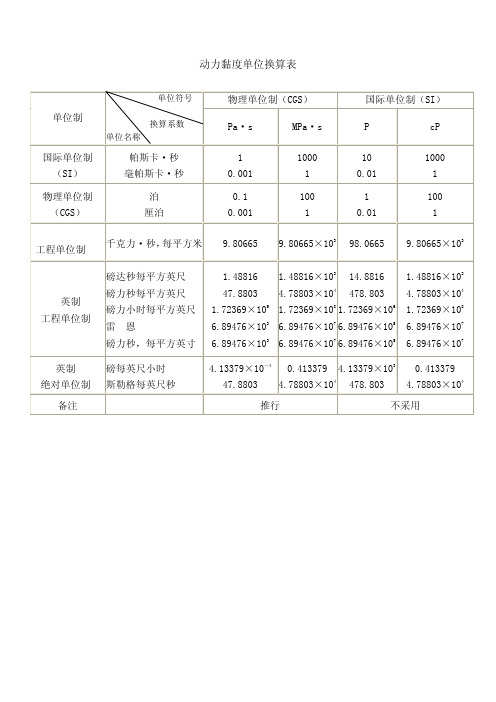
物理单位制(CGS) Pa·s 1 0.001 0.1 0.001 9.80665 1.48816 47.8803 MPa·s 1000 1 100 1 9.80665×103 1.48816×103 4.78803×104
国际单位制(SI) P 10 0.01 1 0.01 98.0665 14.8816 478.803 cP 1000 1 100 1 9.80665×103 1.48816×103 4.78803×104 1.72369×108 6.89476×107 6.89476×107 0.413379 4.78803×104 不采用
ห้องสมุดไป่ตู้
单位制
单位名称
换算系数
国际单位制 (SI) 物理单位制 (CGS)
帕斯卡·秒 毫帕斯卡·秒 泊 厘泊 千克力·秒, 每平方米 磅达秒每平方英尺
工程单位制
英制 工程单位制
磅力秒每平方英尺 磅力小时每平方英尺 雷 恩 磅力秒,每平方英寸
1.72369×105 1.72369×108 1.72369×106 6.89476×103 6.89476×107 6.89476×105 6.89476×103 6.89476×107 6.89476×105 4.13379×10-4 47.8803 0.413379 4.78803×104 推行 4.13379×103 478.803
英制 绝对单位制 备注
磅每英尺小时 斯勒格每英尺秒
动力黏度单位换算表单位制国际单位制si物理单位制cgs单位符号系数pasmpascp国际单00011000100011000010001100001100每平方米9806659806651098066598066510英制工程单位平方英尺磅力小时每平方英14881647880317uot
